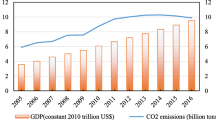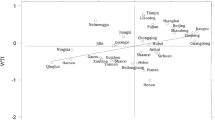Abstract
Low-carbon innovation can address both economic and environmental concerns; patterns of low-carbon innovation convergence can determine the effectiveness of mitigating the adverse consequences of climate change. Considering that economic openness has a huge impact on the development of innovation capability, this paper uses a conditional β convergence model to examine the convergence of low-carbon innovation in Chinese manufacturing industry and its relationship with economic openness. We incorporate the spatial spillover effect into the convergence function by constructing spatial error model, spatial lag model, and spatial Durbin model. Based on a panel data set of 30 Chinese provinces over the period 2004–2016, the results show that low-carbon innovation in Chinese manufacturing industry has a strong feature of conditional β convergence. The convergence rate of low-carbon innovation is slightly slowed down by economic openness, and the main reason is that the spillover effect is weak and the convergence rate is slow in lower open areas, so the convergence rate of the whole country is slowed down by that of the lower open areas. Although the economic openness in adjacent areas can contribute to the development of local innovation ability, but generally speaking, economic openness in local areas takes a stronger effect in promoting the convergence of low-carbon innovation than that in adjacent areas. The findings have important policy implications as they suggest the need for a more equal degree of economic openness among Chinese provinces to speed up the convergence of low-carbon innovation.


Similar content being viewed by others
Notes
For simplicity and readability, sometimes we just write “the low-carbon innovation” instead of “the low-carbon innovation in Chinese manufacturing industry.”
Actually, we have collected the data from 2003 to 2017; however, to calculate the growth rate of low-carbon innovation and to introduce the lag terms of economic openness, R&D investment, and environmental regulation into the econometric model, the sample period is from 2004 to 2016
For example, the correlation coefficient is high between the degree of economic openness and its one-year lag, as is the case for R&D investment and environmental regulation.
References
Aghion P et al (2012) Credit constraints and the cyclicality of r&d investment: evidence from France. J Eur Econ Assoc 10(5):1001–1024
Albino V et al (2014) Understanding the development trends of low-carbon energy technologies: a patent analysis. Appl Energy 135:836–854
Ambos B, Ambos TC (2011) Meeting the challenge of offshoring R&D: an examination of firm- and location-specific factors. R&D Management 41(2):107–119
Archibugi D, Coco A (2005) Is Europe becoming the most dynamic knowledge economy in the world? J Common Mark Stud 43(3):433–459
Archibugi D, Filippetti A (2011) Is the economic crisis impairing convergence in innovation performance across Europe? JCMS: Journal of Common Market Studies 49(6):1153–1182
Barassi MR et al (2011) The stochastic convergence of CO2 emissions: a long memory approach. Environ Resour Econ 49(3):367–385
Baumol WJ (1986) Productivity growth, convergence, and welfare: what the long-run data show. Am Econ Rev 76(5):1072–1085
Brambilla I (2009) Multinationals, technology, and the introduction of varieties of goods. J Int Econ 79(1):89–101
Broitman D, Czamanski D (2021) Endogenous growth in a spatial: the impact of globalization on innovations and convergence. Int Reg Sci Rev 44(3-4):385–399
Cantwell J, Santangelo GD (2000) Capitalism, profits and innovation in the new techno-economic paradigm. J Evol Econ 10(1-2):131–157
Castellani D, Pieri F (2013) R&D offshoring and the productivity growth of European regions. Res Policy 42(9):1581–1594
Chen VZ, Li J, Shapiro DM (2012) International reverse spillover effects on parent firms: evidences from emerging-market MNEs in developed markets. Eur Manag J 30:204–218
Chen S, Shi A, Wang X (2020) Carbon emission curbing effects and influencing mechanisms of China’s emission trading scheme: the mediating roles of technique effect, composition effect and allocation effect. J Clean Prod 264:121700
Cheng Z (2016) The spatial correlation and interaction between manufacturing agglomeration and environmental pollution. Ecol Indic 2016(61):1024–1032
Child j, Rodrigues SB (2005) The internationalization of Chinese firms: a case for theoretical extension? Manag Organ Rev 1(3):381–410
Churchill SA et al (2018) Conditional convergence in per capita carbon emissions since 1900. Appl Energy 228:916–927
Costantini V, Crespi F, Palma A (2017) Characterizing the policy mix and its impact on eco-innovation: a patent analysis of energy-efficient technologies. Res Policy 46(4):799–819
Dai L et al (2021) The impact of outward foreign direct investment on green innovation: the threshold effect of environmental regulation. Environ Sci Pollut Res 28(26):34868–34884
Deng P (2008) Why do Chinese firms tend to acquire strategic assets in international expansion? J World Bus 44(1):74–84
Ecker B et al (2013) Management control and the decentralization of R&D. J Manag 39(4):906–927
Elhorst JP (2014) Matlab software for spatial panels. Int Reg Sci Rev 37(3):389–405
Giuliani E et al (2005) Upgrading in global value chains: lessons from Latin American clusters. World Dev 33(4):549–573
Grafström J (2018) Divergence of renewable energy invention efforts in Europe: an econometric analysis based on patent counts. Environ Econ Policy Stud 20(4):829–859
Guadalupe M, Kuzmina O, Thomas C (2012) Innovation and foreign ownership. Am Econ Rev 102(7):3594–3627
Huang J et al (2019) Convergence analysis of China’s energy intensity at the industrial sector level. Environ Sci Pollut Res 26:7730–7742
Hundley G, Jacobson CK, Park SH (1996) Effects of profitability and liquidity on R&D intensity: Japanese and U.S. companies compared. Acad Manag J 39(6):1659–1674
Ivarsson I, Alvstam C, Vahlne J (2017) Global technology development by colocating R&D and manufacturing: the case of Swedish manufacturing MNEs. Ind Corp Chang 26(1):149–168
Javorcik BS (2004) Does foreign direct investment increase the productivity of domestic firms? In search of spillovers through backward linkages. Am Econ Rev 94(3):605–627
Javorcik BS, Turco AL, Maggioni D (2018) New and improved: does FDI boost production complexity in host countries? Econ J 128(614):2507–2537
Jungmittag A (2006) Innovation dynamics in the EU: convergence or divergence? A cross-country panel data analysis. Empir Econ 31(2):313–331
Kijek T et al (2021) The patterns of energy innovation convergence across European countries. Energies 14(10):2755–2755
Lampel J, Bhalla A (2011) Living with offshoring: the impact of offshoring on the evolution of organizational configurations. J World Bus 46(3):346–358
Hakanson L, Nobel R (1993) Determinants of foreign R&D in Swedish multinationals. Res Policy 22(5-6):397–411
Lee K, Szapiro M, Mao Z (2018) From global value chains (GVC) to innovation systems for local value chains and knowledge creation. Eur J Dev Res 30(3):424–441
Li J et al (2017) Convergence of carbon intensity in the Yangtze River Delta, China. Habitat International 60:58–68
Li H et al (2021) Spatial distribution and convergence of provincial carbon intensity in China and its influencing factors: a spatial panel analysis from 2000 to 2017. Environ Sci Pollut Res. https://doi.org/10.1007/s11356-021-14375-7
Liu X, Buck T (2007) Innovation performance and channels for international technology spillovers: evidence from Chinese high-tech industries. Res Policy 36(3):355–366
Lucas RE (1990) Why doesn’t capital flow from rich to poor countries? Am Econ Rev 80(2):92–96
Mathews JA, Zander I (2007) The International Entrepreneurial Dynamics of Accelerated Internationalisation. J Int Bus Stud 38(3):387–403
Miao C et al (2021) Spatial heterogeneity and evolution trend of regional green innovation efficiency--an empirical study based on panel data of industrial enterprises in China's provinces*. Energy Policy 156:112370
Moutinho V et al (2014) Carbon dioxide emissions intensity of Portuguese industry and energy sectors: a convergence analysis and econometric approach. Renew Sust Energ Rev 40:438–449
Paas T, Schlitte F (2006) Regional Income Inequalities and Convergence Processes in the EU-25. HWWA Discussion Paper 355.
Payne JE, Apergis N (2021) Convergence of per capita carbon dioxide emissions among developing countries: evidence from stochastic and club convergence tests. Environ Sci Pollut Res Int 28(26):33751–33763
Perroux F (1950) Economic space: theory and applications. Q J Econ 64(1):89–104
Pisani N, Ricart JE (2018) Offshoring innovation to emerging countries: the effects of IP protection and cultural differences on firms’ decision to augment versus exploit home-base-knowledge. Manag Int Rev 58(6):871–909
Porter ME (1991) America’s green strategy. Sci Am 264(4):168
Porter ME (2000) Location, competition, and economic development: local clusters in a global economy. Econ Dev Q 14(1):15–34
Qin H, Huang Q, Zhang Z et al (2019) Carbon dioxide emission driving factors analysis and policy implications of Chinese cities: combining geographically weighted regression with two-step cluster. Sci Total Environ 2019(684):413–424
Qu Z et al (2013) R&D offshoring, technology learning and R&D efforts of host country firms in emerging economies. Res Policy 42(2):502–516
Rui H, Bruyaka O (2021) Strategic network orchestration in emerging markets: China’s catch-up in the high-speed train industry. Br J Manag 32(1):97–123
Rungi A, Prete DD (2018) The smile curve at the firm level: where value is added along supply chains. Econ Lett 164:38–42
Solarin SA (2019) Convergence in CO2 emissions, carbon footprint and ecological footprint: evidence from OECD countries. Environ Sci Pollut Res 26(6):6167–6181
Solow RM (1956) A contribution to the theory of economic growth. Q J Econ 70(1):65–94
Steven G, Daniel S, Aidan V (2005) Clusters and intercluster spillovers: their influence on the growth and survival of Canadian information technology firms. Ind Corp Chang 14(1):27–60
Su C et al (2021) Reverse innovation transfer in Chinese MNCs: The role of political ties and headquarters. J Int Manag 27(1)
Sun H et al (2020) Estimating environmental efficiency and convergence: 1980 to 2016. Energy 208:118224
Wong CY et al (2014) Examining the patterns of innovation in low carbon energy science and technology: publications and patents of Asian emerging economies. Energy Policy 73:789–802
Xu H, et al. (2021) Does regional planning policy of Yangtze River Delta improve green technology innovation? Evidence from a quasi-natural experiment in China. Environmental science and pollution research international
Yan Z et al (2017) Convergence or divergence? Understanding the global development trend of low-carbon technologies. Energy Policy 109:499–509
Yang C, Liu S (2020) Spatial correlation analysis of low-carbon innovation: a case study of manufacturing patents in China. J Clean Prod 273:122893. https://doi.org/10.1016/j.jclepro.2020.122893
Yang X et al (2021) Does high-speed railway promote regional innovation growth or innovation convergence? Technol Soc 64:101472
Yu S et al (2018) Convergence of carbon emissions intensity across Chinese industrial sectors. J Clean Prod 194:179–192
Zhang N, Wang B, Liu Z (2016) Carbon emissions dynamics, efficiency gains, and technological innovation in China's industrial sectors. Energy 99:10–19
Data availability
The data that support the findings of this study are available from incoPat database; “China Statistical Yearbook on Science and Technology”; the website of China National Bureau of Statistics, Ministry of Commerce of China, and China National Bureau of Statistics and Ministry of environmental protection of China; and China Stock Market & Accounting Research Database.
Funding
This research is supported by the National Natural Science Foundation of China (71964019), Applied Basic Research Foundation of Yunnan Province (CN) (202001AT070095), Science Research Foundation of Yunnan Education Bureau (CN) (2019Y0042).
Author information
Authors and Affiliations
Contributions
Chaojun Yang: Supervision, Conceptualization, Methodology, Review, Funding acquisition. Liju Liu: Writing, original draft; Software; Formal analysis. Zhaoran Wang: Resources, Supervision, Validation. Lishan Liu: Writing, review and editing; Writing, major revision; Conceptualization, Methodology, Data curation, Formal analysis.
Corresponding author
Ethics declarations
Ethics approval and consent to participate
Not applicable.
Consent for publication
Not applicable.
Competing interests
The authors declare no competing interests.
Additional information
Responsible Editor: Roula Inglesi-Lotz
Publisher’s note
Springer Nature remains neutral with regard to jurisdictional claims in published maps and institutional affiliations.
Rights and permissions
About this article
Cite this article
Yang, ., Liu, L., Wang, Z. et al. Convergence or divergence? The effects of economic openness on low-carbon innovation in Chinese manufacturing industry. Environ Sci Pollut Res 29, 14889–14902 (2022). https://doi.org/10.1007/s11356-021-16819-6
Received:
Accepted:
Published:
Issue Date:
DOI: https://doi.org/10.1007/s11356-021-16819-6




